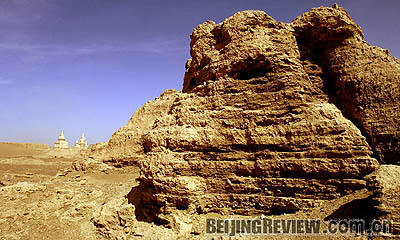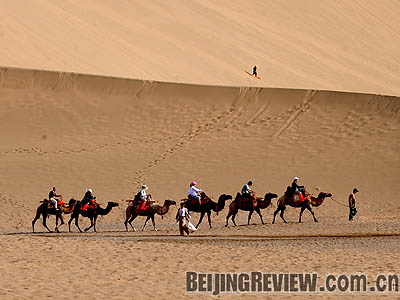|

FADING GLORY: The ancient town of Heishui, one of the major transfer hubs along the ancient Silk Road, today lies in ruins
China, together with five central Asian countries, will jointly apply to the United Nations Educational, Scientific and Cultural Organization (UNESCO) to add the Silk Road as a world heritage to be voted on in 2010. The other countries are Kazakhstan, Uzbekistan, Kirghizstan, Turkmenistan and Tadzhikistan.
This was confirmed by Shan Jixiang, Minister of the State Administration of Cultural Heritage, in Beijing on September 2. According to him, up to now all the coordination work among these countries has been done. The more than 100 historical sites related to the Silk Road were chosen as the major relics of the ancient trade route, of which 48 are located in China.
Silk Road-the beginnings
In ancient times, the Silk Road was an important trade route across the Asian continent, connecting eastern, southern and western Asia with the Mediterranean world including North Africa and Europe.
It has a very long history. In 139 B.C. and 119 B.C. respectively, Emperor Wudi of the West Han Dynasty (202B.C.-8A.D.) sent his envoy Zhang Qian to the Western Regions, a term used in the Han Dynasty to describe the areas west of the Yumenguan Pass, which includes the present Xinjiang Uygur Autonomous Region of China and parts of Central Asia. Since then, a route connecting China and the western world went into use.
The Silk Road is an extensive interconnected network of many trade routes. Basically speaking, it includes three trade lines in the north, middle and south respectively. To the East Han Dynasty (25-220), the Silk Road had extended to the east coast of the Mediterranean Sea westward, starting from the Capital Chang'an, now Xi'an, capital of Shaanxi Province in west China. Extending over 8,000 km, the route gained further development during the prosperous Tang Dynasty (618-907), greatly facilitating the trade and cultural exchanges between China and the Roman Empire (27 B.C.-A.D.476).

Since the route was created, the trade connection between China and Central Asia and Europe has rapidly increased. Through this route that connects Asia and Europe, Chinese products, such as silk, were constantly transported to the West. And as silk products were the major goods transported along this route, it was given the name Silk Road by German geographer Ferdinand von Richthofen in 1877, and the name stuck.
|
